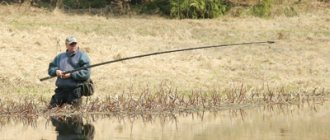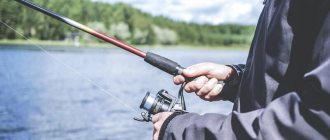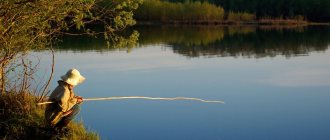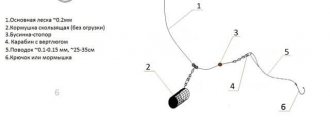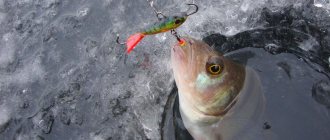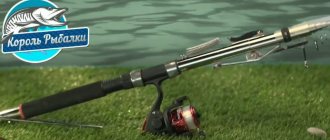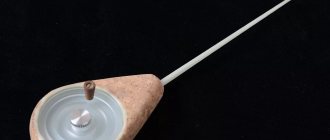Winter float rod
, like its summer version, has a lot of varieties. In particular, there are fishing rods for roach and silver bream. And there is one for fishing for bream and carp.
The difference between these options is due to the difference in fish behavior in winter and summer. In winter, non-predatory fish, namely, the winter float fishing rod is mainly intended for catching them, are much less mobile and more careful. Therefore, all elements of the gear are made thinner and more inconspicuous.
Fishing with a winter float rod is one of the most interesting, productive and popular types of fishing. For a large army of bream fishermen, a float rod is the main fishing tool. However, this tackle is also suitable for catching other fish, in particular roach. At first glance, fishing with a float is simple and unsophisticated. However, this is not quite true. The design of float gear, its adjustment and handling require certain knowledge and skill. There are situations when float tackle becomes almost indispensable for achieving success, when the bite of “white fish” is weak and very capricious, when even a small jig causes rejection in the fish, a hook with a nozzle can work wonders.
Of course, it is more convenient and faster to look for fish using nodding tackle, but having discovered a school, some fishermen switch, for some reason, to fishing with float rods.
Content
- 1 Types of winter fishing rods 1.1 Balalaika winter tackle
- 1.2 Winter fishing rod “filly”
- 1.3 Winter float rod
- 1.4 Winter tackle for trolling
- 1.5 Reelless winter fishing rod
- 1.6 Electronic ice fishing rod
- 2.1 Fishing rods for trolling
- 3.1 Equipment “steam locomotive”
- 6.1 Rating of the best Top fishing rods
Electronic fishing rods for winter fishing
When considering simple winter fishing rods, it is important not to miss another type - electronic fishing rods for winter fishing. Some fishermen confuse them with a barbaric and merciless fishing tool - an electric fishing rod. However, we hasten to dispel all doubts - these fishing options have completely different operating principles. Since we are against poaching, we will consider the operating principle and advantages of only one option - fishing with an electronic fishing rod for winter fishing.
What it looks like. Outwardly, it is similar to a regular one: a handle, a whip, a nod and a reel. Its main feature is an electromechanical force that animates the bait in the water.
- Pros: the fisherman gets less tired, the game with the bait can be adjusted as accurately as possible, the animation will occur without “glitches”.
- Disadvantages: difficult maintenance (batteries, fine adjustments, careful attitude), lack of physical contact of the hand and bite. The fisherman can only watch the nod or whip (if a nodless fishing rod is used) and hook the fish in time.
Varieties of winter fishing rods
Varieties of winter fishing rods
Varieties of winter fishing rods are distinguished by their purpose and the baits used; there are the following fishing rods for ice fishing:
- jig fishing rod
- winter float fishing rod
- fishing rod for trolling.
In addition, according to their design, the following types of winter fishing rods are distinguished:
- “filly”, or fishing rod without a reel
- fishing rod with handle and reel
- “balalaika”, in which the reel is hidden directly in the handle of the fishing rod.
Winter tackle "balalaika"
It received its name for a certain similarity with the musical instrument of the same name. This fairly popular fishing rod is characterized by the absence of a pronounced handle - instead, the reel spool is hidden in the cavity of the body and at the same time plays the role of a handle. The design of such a winter fishing rod has its advantage, namely a shift in the center of gravity to the base, which is reflected in the play of the jig. When installing such a fishing rod on ice, you need to use special spacers, which are usually sold complete with it.
The body of such a balalaika is often made of foam or plastic. When choosing such a fishing rod, it is recommended to pay attention to the size and quality of the reel, since in low-quality products the line constantly falls into the space between the spool and the body. It is desirable that the handle has a recess for the fisherman’s finger - this is more reliable in frosty weather conditions. Another type of balalaika is a winter axleless fishing rod called “sport”. Which has proven itself well among winter fishing enthusiasts.
Winter fishing rod "filly"
It is the simplest and simplest fishing rod for ice fishing. Typically made from polystyrene foam. This fishing rod is not equipped with a reel, but the fishing line is wound on a reel cut into the body of the handle itself. These fishing rods require the most sensitive whip (bite indicator) - this is due to the design itself, or rather its weight, which is transferred to the game with the jig. Homemade winter fishing rods made of polystyrene foam of the “filly” type are good, first of all, for lovers of reelless fishing. In this case, the fisherman feels the jig perfectly even at several meters of depth.
Winter float rod
Winter fishing rod
The most convenient option can be considered a fishing rod with a separate reel and handle, but a “filly” is also suitable. Since in this case we are talking about passive fishing, the fishing rod must be equipped with stands. It is perfect for catching various white fish, especially roach, silver bream, and bream.
In order to fully understand what winter fishing rods are and how they differ from each other, it is worth trying ice fishing with both a float and a jig and spinner. However, one should not think that such fishing is akin to the usual summer fishing. Increased demands are placed on winter gear.
Firstly, the diameter of the fishing line used for such fishing should be minimal. This thread is very difficult to work with in cold weather and requires considerable skill, and fishermen often dye it a dark color to make it visible in the snow. The hook for ice fishing is very elegant, with an elongated shank and a spatula for tying to the fishing line. Fishing with a winter fishing rod with a float requires very sensitive loading of the gear.
In this case, a miniature, brightly colored float is taken, which is most often sunk under the surface of the water. This delicate equipment is associated with the caution of the fish, and the float, which floats on the surface of the water in the hole, can become icy, which will immediately reduce its sensitivity.
Winter tackle for trolling
Active predator fishing in winter is truly interesting. For trolling, longer rods, up to a meter long, can be used. The tackle itself is not complicated, however, in this case we will need a nod, especially when it comes to bites, for example, of a medium-sized perch.
To store fishing line, the tackle must be equipped with a reel; it may even be inertialess. The main requirement for it is that it can withstand low air temperatures well. We should choose a fishing line that is strong enough and of high quality, since we are going to catch a predator. When fishing with a winter line, the lure plays a primary role. However, there is no universal attachment, so you need to experiment with spinners of different types and sizes, and also depending on the nature of the reservoir.
Reelless winter fishing rod
For ice fishing without bloodworms, maggots or other baits, a winter mothless bait is intended. According to the testimony of experienced fishermen, fishing itself can be considered one of the most exciting activities. But there are also some limitations: the fishing technique requires masterly play with a jig, so it cannot be called passive. Therefore, experienced fishermen make such fishing rods at home with their own hands from scrap materials such as cork and foam. Champagne corks have become especially popular for making such works of art.
The main feature of such a fishing rod is its minimum weight in order to feel the play of the bait. But even small change will not be tempted by an empty jig, unlike more impressive specimens. Jigs for this method of fishing are something akin to works of art. They are much smaller than usual, in addition, in order to impress the fish, various small decorations are used on them. For example, colored cambrics, beads, threads, foam balls, etc. If you are puzzled about which winter fishing rod to choose for catching roach or small perch, then feel free to try a reelless rod, just don’t forget to equip it with a bead - yellow, white, red.
Particularly popular is the “devil” jig, which looks like an elongated inverted droplet. To work effectively, such a bait must have a hole in the center, passing through a longitudinal symmetrical axis.
Electronic ice fishing rod
An interesting and quite catchy tackle for catching perch, great for lazy fishermen. The device has proven itself even when fishing in severe frosts, is not afraid of moisture and runs on AA batteries. When listing the types of winter fishing rods, it would be unforgivable not to mention such fishing equipment.
In modern analogues, there are several operating modes that provide different amplitudes of oscillation of the tackle, which affects the play of the jig. The most famous is the electronic winter fishing rod “Luck 2”, which has a moisture-resistant body. On different holes of the reservoir, you can experiment with the modes of operation of the fishing rod and, thereby, achieve excellent results. During hooking, the bite alarm is turned off. The body of the fishing rod is made on the same principle as a balalaika fishing rod.
Types of fishing rods for winter fishing
Previously, a fishing rod was made from juniper and wrapped with reeds; horsehair replaced the fishing line. Now, in addition to the differences in baits, fishing rods are divided into four categories:
- classic fishing rods with a float;
- spinning;
- fishing rods suitable for jig fishing;
- fishing rods used for fishing with a balance beam or spoon.
Float rods are the most common option for winter fishing. A fishing rod consists of a reel, fishing rod, fishing line, hook and float. In winter fishing, a short rod is used. There is no need to cast it over a distance, you just need to hook the fish.
You need to be able to choose a fishing rod: it is recommended to pay attention to strength, it is important what material the rod is made of, the material should bend a little, which makes it easier to catch fish, it should be light.
Choosing a fishing rod for winter fishing
Floats for a winter float fishing rod
To decide on the choice of fishing rod, imagine who you are going to catch. White fish are caught using a float and a jig; very careful equipment is required. Predatory fish in winter are better caught with spoons, especially on the first and last ice, which is stronger here. Fishing rods for spinners and jigs, in my opinion, are the most successful Finnish and Baltic ones. The thickness of the fishing line depends on what kind of fish and what kind of bait you are going to catch.
Fishing rods for trolling
The fishing rod should be light, durable, with an open, easily rotating reel that holds enough line to fish at different depths. In addition, the open spool allows you to control the quantity and quality of fishing line winding, which is very important when biting large fish. The stopper of the fishing rod for the spinner should be reliable, with good fixation, which will allow you to make a confident hook. Very successful key stoppers, they are comfortable and reliable, the line is easy to reel in, and even easier to unwind, which is especially important when fishing in the current. The whip is removable, which is convenient for transportation, since lure fishing is usually done while standing, it is selected longer.
By and large, the length and stiffness of the whip are very individual. They are selected depending on the size of the expected fish, the size and weight of the bait, the diameter of the fishing line and many other parameters. For example, you are fishing with a light 1-2 gram spinner on a very thin line, a sharp hook with a hard whip will inevitably lead to a break. Understanding all the nuances comes with experience in lure fishing. Nodding the rod is a matter of taste; usually it only serves to register a bite, but it can be necessary when fishing with small baits. It is advised to put a nod; in the dark, when a large pike perch is biting, you can only notice it. In addition, it helps to diversify the game; you can “jig” with a spoon, sometimes the fish like it. Pay special attention to the handle; it should be long enough; in very cold weather you have to wear mittens when fishing. A good material for a handle is neoprene or cork, however, a neoprene handle freezes when water gets on it.
When choosing a fishing rod for trolling, pay attention that it should “fit” in your hand, that is, be comfortable; you have to fish all day. Comfortable Finnish fishing rods Teho. Easy to assemble and disassemble, a reliable reel with a comfortable key, a soft stroke and a good diameter of winding line that lays evenly on the reel. I had three of different diameters, in the second year one broke when hooking a large fish, the handle flew off. The other two have been serving for seven years. Finnish fishing rods are light and durable, they can be easily thrown onto the ice, they are light in weight and size, which is very important. It’s better to immediately equip several lure fishing rods for different fishing conditions.
Fishing rods for jig fishing
The fishing rod is better than the balalaika, it is easy to make a clear retrieve, and is ideal for playing light spinners in shallow water. The main requirements are low weight, smooth and soft stroke of the reel, a reliable wing that clamps the spool, and a medium-hard whip 13-18 cm long, and what is important is that it should be a fishing rod that is comfortable for you. You have to hold it in your hands all day long, and not just throw the bait, but literally “cross-stitch” it; it’s not for nothing that those who catch with jigs are called “shakers and boogers.” The balalaika consists of a lightweight, usually round or drop-shaped foam body and a closed coil, a short whip and a nod. An integral part of a jig fishing rod is the nod. They are given the desired game, he shows the bite and saves the line from breaking during a sharp hook. The requirements for the nod are simple: it should not be rigid, show the most delicate bite, be easily attached to the fishing rod, not deform and be extremely light. There are a large number of nods on sale, metal, spring, lavsan, there is plenty to choose from. But there are no universal nods; they must be selected for specific fish and fishing conditions.
Unfortunately, balalaikas have flaws; domestic, Baltic and Finnish fishing rods have them. Unreliable wings that spontaneously unwind or tighten, various kinds of scuffs on the reel socket and in the hole for the fishing line. The whip is not always suitable, it is too hard or soft, there is a large residual deformation. When purchasing, inspect several fishing rods at once, twist and move the reel in the socket, see how the reel and body fit together. This is not a 100% guarantee, but it will help avoid obvious defects. The reel on the fishing rod should work without involuntary dropping of the line, which occurs when the reel moves too freely. In this case, the line is either wound around the axle or comes out in loops between the body and the reel.
To eliminate the idling of the reel, put a fluoroplastic ring on the axle, and remove all burrs on the body with fine sandpaper. Many fishermen grind off the hump on the outside of the fishing rod (if there is one). This achieves an additional reduction in the weight of the gear. In addition, when hooking, the fishing rod is thrown onto the ice, and when pulled up by a thin fishing line, it glides without getting stuck. There are “telephone” winter fishing rods, the most unfortunate design of all existing winter fishing rods. Not only is it cold plastic, but spinning the disc with frozen and often wet hands is also a pleasure. Some fishermen make winter fishing rods with their own hands.
Types of fishing rods for winter fishing
For jigs
A fishing rod for winter fishing, which is used when fishing with a jig, is small in size, comfortable and light in weight. Fishermen appreciate this type of rod because catching fish with it is not difficult. Fishing with a jig has a playful nature, because of this the tackle should not be heavy, otherwise you won’t see fish. This fishing rod has a reel in the form of a handle. It is presented in a closed form and therefore it is very convenient to hold the rod.
Due to the short distance of the fisherman from the hole, the whip should not be long. But still, a certain number of fishermen have mastered fishing with long rods, but it is still not as easy as with short ones. In order for the catch to be rich, you need to purchase fishing rods with a friction clutch. With its help, the reel quickly scrolls, which allows you to save the fishing line from breaking.
Fishing rod with a nod
A fishing rod with a nod is a special tackle; instead of a float, it has a side nod at the extreme part of the rod. A jig is used as bait for summer fishing. Side nod fishing is very common among anglers. And all because such exceptionally convenient tackle provides a good bite even in places with heavy vegetation. The advantage of such a fishing rod is the play of the float, even when the fishing rod is swaying. With the help of such a structure you can catch carp, crucian carp, bream, or roach. But if you add additional bait, there is a chance of getting zander, perch and pike.
Delivery
A special feature of the supply is its simple manufacturing, without any defects in the elements of the gear. It will be quite problematic to find in special stores, but it is more than possible to build one at home. There are several ways to do this.
To prepare the supplies you need:
- durable stick made of wood;
- a piece of rubber hose;
- awl;
- fishing line;
- hooks;
- knife;
- sinker.
The process of fishing with a reel is quite simple. The main rule is to find an area that is promising and where the pike needs food. The production of live bait must be carried out in advance; it can be ruff, perch or roach. For supply, the catch is usually from 1 to 3 meters.
Zherlitsy
In appearance, the girders are similar to a slingshot made of wood. The rod can also be made of wire material with equipment wound around it.
Fishing with girders takes place in such reservoirs as small rivers, streams with fallen tree trunks, reservoirs and flooded large rivers. The advantages of the girder are easy production, quick collection of gear, self-hooking of fish, and lack of constant control.
Float rods
Float rods have a long history. When choosing a float rod for fishing, you need to focus on the correct assembly of the float. Often a conical shape is taken. To make this item, you need to stock up on materials such as foam or cork; after completion, they can be painted in a bright color. The standard diameter of the float should not exceed 6 cm, and the length 3 cm. The main component of successful fishing with a float is the sinker, because without it the float tends to be on the surface. The created sinker must be made of lead or tin. The best shape for a sinker is an oval.
Gear for strong currents
Most fishermen believe that fishing with a float in a strong current is different from still water. But on any body of water, even in calm weather, there will be a weak current, so gear for strong currents is very popular.
Tackle for lures and balancer
It is necessary to stock up on tackle with a spoon or balancer if the fisherman plans to fish for a predator or catch a large trophy. The rod has a reel and reel. The advantage of such fishing rods is the elastic rod, with the help of which quick hooking occurs. For fishermen who prefer standing fishing, it is recommended to use long rods. For convenience, they are designed to be collapsible so that there are no storage problems.
Electronic fishing rod
An electronic fishing rod for winter fishing is designed in such a way that, with the help of a mechanism, the whip begins to oscillate, twitch and jump, and therefore moves the jig. The catchability of this type of gear has not been determined. Nothing can replace the experienced hand of a fisherman.
Self-hooking fishing rod for winter fishing
A self-hooking fishing rod for winter fishing is very effective. It carries out effective fishing due to automatic hooking. Helps increase the angler's free time, which he can spend on preparing the site or collecting other fishing rods.
Equipment
Equipment for a winter float fishing rod
It is very important to properly equip the fishing rod depending on the reservoir, the presence of current, depth, and type of fish. The final option always remains with the fisherman and is based on his personal experience.
Those fishing rods that are sold in stores require some modification. To do this, you need to unscrew the screw and remove the spool. The design is somewhat poorly thought out and where the fishing line enters, it can rub against the edges of the reel. To prevent this from happening, a cambric should be installed in this place, which will also help to carefully lay the fishing line on the reel. The line is then wound onto the reel. To do this, a loop is made at the end of the fishing line, with the help of which the fishing line is secured to the spool. The tip is selected according to the weight of the jig. To prevent the line from getting tangled, a cambric is installed parallel to the whip. Then the fishing line is passed through all the holes and a jig is tied to it. You can tie it with any knot, the main thing is that it is secure. Since the fishing line used is very thin (0.06-0.1mm), the fishing rod must be very sensitive and the design must be well thought out.
How to assemble a fishing rod for ice fishing:
- Wind the line onto the spool by turning the reel handle clockwise.
- Install the whip.
- Put on the tip.
- Pass the line through all the holes.
- If necessary, install a float.
- Attach bait (jigs).
It is advisable that the equipment for a winter fishing rod be tested at home, so that you do not have to experiment in the cold.
The Balalaika can be used for fishing with or without a bait. The whip is selected depending on the intended fish to be caught. For perch, for example, you can equip your fishing rod with a standard plastic whip. At shallow depths, you should use a flexible whip to dampen sudden jerks of the fish.
A nod made from wild boar bristles is considered the best, although it can also be made from X-ray film. As a last resort, you can use the factory version. For the nod to work correctly, a setup process is carried out, which consists of the following: the nod is installed and a jig is hung on its tip; the nod moves back and forth until it bends no more than 5-8mm under the weight of the jig.
Equipment "steam locomotive"
Shipment of a winter float fishing rod
This equipment requires the presence of two jigs or a jig and a hook on the fishing line. In this case, the float should be somewhat recessed, and the nod should practically not bend. This way the two jigs are considered to be balanced and there is full contact with the rod. When rigging your fishing rod, you should take into account the bottom topography and the depth of the reservoir. For deep reservoirs, and especially in currents, you should use tungsten baits, which are heavier than usual.
How to equip a fishing rod for winter fishing
It is very important to properly equip the fishing rod depending on the reservoir, the presence of current, depth, and type of fish. The final option always remains with the fisherman and is based on his personal experience.
Tips for rigging a balalaika
Those fishing rods that are sold in stores require some modification. To do this, you need to unscrew the screw and remove the spool. The design is somewhat poorly thought out and where the fishing line enters, it can rub against the edges of the reel. To prevent this from happening, a cambric should be installed in this place, which will also help to carefully lay the fishing line on the reel. The line is then wound onto the reel. To do this, a loop is made at the end of the fishing line, with the help of which the fishing line is secured to the spool. The tip is selected according to the weight of the jig. To prevent the line from getting tangled, a cambric is installed parallel to the whip. Then the fishing line is passed through all the holes and a jig is tied to it. You can tie it with any knot, the main thing is that it is secure. Since the fishing line used is very thin (0.06-0.1mm), the fishing rod must be very sensitive and the design must be well thought out.
Important Assembly Steps
How to assemble a fishing rod for ice fishing:
- Wind the line onto the spool by turning the reel handle clockwise.
- Install the whip.
- Put on the tip.
- Pass the line through all the holes.
- If necessary, install a float.
- Attach bait (jigs).
It is advisable that the equipment for a winter fishing rod be tested at home, so that you do not have to experiment in the cold.
Whip
The Balalaika can be used for fishing with or without a bait. The whip is selected depending on the intended fish to be caught. For perch, for example, you can equip your fishing rod with a standard plastic whip. At shallow depths, you should use a flexible whip to dampen sudden jerks of the fish.
Nod
A nod made from wild boar bristles is considered the best, although it can also be made from X-ray film. As a last resort, you can use the factory version.
For proper operation of the nod, a setup process is carried out, which is as follows:
- A nod is installed and a jig is hung on its tip.
- The nod moves back and forth until it bends no more than 5-8mm under the weight of the jig.
Equipment "steam locomotive"
This equipment requires the presence of two jigs or a jig and a hook on the fishing line. In this case, the float should be somewhat recessed, and the nod should practically not bend. This way the two jigs are considered to be balanced and there is full contact with the rod. When rigging your fishing rod, you should take into account the bottom topography and the depth of the reservoir. For deep reservoirs, and especially in currents, you should use tungsten baits, which are heavier than usual.
Jig fishing technique
When fishing with a jig, constant work and vigilance are required. The line should not get tangled in mittens or gloves. For an inexperienced fisherman, a thin fishing line easily breaks when biting a larger or smaller perch or when it gets caught on the edge of the ice while pulling out a fish. When going on winter fishing, they take with them a supply of jigs, since they are easier to lose than spoons. With good reason, jig fishing can be considered the most difficult of all types of fishing. Bloodworms, maggots or a small worm are used as bait. Even a piece of red wool thread will do. During fishing, slush is usually removed from the hole. The jig is lowered to the bottom. The tip of the fishing rod is placed about two centimeters above the surface of the water. Then the jig is slowly raised, causing it to constantly shake. There are many ways to play this game: fast shaking, bobbing up and down, clicking the rod, etc. Everyone should find the style that suits their hand best. Sometimes the fish does not agree to tear itself away from the bottom even for the sake of appearance. It happens that fish can only be teased at a depth of a meter or one and a half meters. Sometimes the fisherman even has to stand up to do this. When biting, the nod bends downwards. Do not hook too sharply to avoid breaking the line or pulling the jig out of the fish's mouth. You need to hook with a light jerk, which is like a slightly faster continuation of the rise. Holding the line with bare fingers, they calmly determine the behavior of the fish and estimate its weight. The tension of the fishing line cannot be relaxed for a single moment. The weight of the fish will determine how quickly it rises. If the fish is large, you need to monitor its movement and skillfully guide it into the hole. And at this last stage the line must be taut. As soon as the head of the fish is raised to the surface of the water, it is grabbed with your fingers and thrown onto the ice.
Fishing rod for jig fishing
Depending on the design, fishing rods for jig fishing are divided into three categories; fishermen named them in accordance with the objects that these rods resemble: the first fishing rod is shown in Fig. 1 is a filly, the second fishing rod is an integral element of the reel and rod and is called a balalaika - figure 2. And the third type of fishing rod is a classic - rods with an open reel - 3 figure.
Almost all fishermen, when actively fishing with a jig with a bloodworm attached, prefer the balalaika. Its advantage is its design, which allows you to comfortably place the rod in your hand and play with it without straining. You can often see athletes fishing with a balalaika. And they, by the way, play with a jig quite quickly. And in competitions with limited fishing time, you will not find a replacement for the balalaika.
If you are not pressed for time and you can spend a lot of time fishing, then there is simply no need to use a balalaika. Very often, fish prefer a lying bait, and putting this type of fishing rod will not work. She just doesn't have legs. Sometimes I had to do this, but shoveling a pile of ice near the hole every time you want to put the fishing rod down is not very convenient.
The second factor that you should pay attention to when choosing a fishing rod for jig fishing is temperature. In the cold, you won’t be able to sit for long with your bare hands, and it’s uncomfortable to play with a jig while wearing mittens. Here the balalaika immediately disappears and a fishing rod with an open reel, which already has legs, comes to the rescue. If you really want to, you can fish with such a rod even in down mittens (I tried it).
But the filly was the first to appear; it is considered the oldest type of winter fishing rod. It has a very simple design. But its main advantage is the reel, which plays the role of legs. This jig fishing rod is easy to move from hole to hole and your line will never get tangled.
Advantages of a winter fishing rod with a retractable leash
As a matter of fact, the advantages of a winter fishing rod with a retractable leash over the same “classics” are obvious and are as follows:
- An excellent opportunity to adapt to absolutely any fishing conditions! To do this, you just need to have sets of leashes of different sizes with hooks, floats and sinkers. Moreover, in this way you can adapt not only to any fishing conditions, but also to any fish! The diameter of the main line, as a rule, ranges from 0.12 to 0.18 mm. For example, if fishing takes place in a strong current, you need to put a weight of 7–10 grams and select a float that would not be carried under the ice by the current. If fishing takes place in a body of water with a weak current, then change the load to 2-3 grams, and set the float light, approximately up to a gram.
- The location of the baited hook quite far from the main line is one of the main advantages of this equipment. There is a hypothesis floating around among anglers that suggests the reason for the poor bite, especially in the middle of nowhere, is that the fish don’t particularly like to rub their sides against the main fishing line. And this, undoubtedly, happens if you fish with “classics”. The retractable leash makes it possible to place the bait at least half a meter from the main line, which significantly calms the fish, dulling its attention! As a rule, leashes with a length of 20 cm or more are used in this equipment, since shorter ones simply do not justify themselves!
- Fast loading of equipment. For example, a load weighing 3 grams instantly delivers the equipment to the proper depth, and a float weighing 0.2 - 0.3 grams immediately shows a bite, after which a hook follows even before the fish feels the weight of the load!
- Impacts of the load on the bottom. Each time the equipment is lowered to the bottom, a heavy load, hitting the bottom, raises a cloud of turbidity, which also attracts not very active fish. Experienced fishermen, if there is no bite for a long time, periodically raise and lower the equipment, causing this effect.
- Availability of bait to fish. The fact is that the load that sinks to the bottom is completely immersed in the silt, and the leash with the hook and bait smoothly sinks a little to the side of it, lying on the sediment, without drowning in it!
Recommendations for choosing a fishing rod
Equipment for a winter fishing rod
There is simply no concept of universal fishing rods for winter fishing. A fisherman should have several rods in his arsenal that are designed for specific fishing conditions. Most fishermen use store-bought fishing rods, a minority try to modernize them a little, and only a few make their own rods.
So what should a fisherman be guided by when choosing a fishing rod? During the dry winter period, you need to choose lighter gear. In bodies of water with great depth or strong currents, larger gear can be used. When you buy a fishing rod in a store or at the market, you should pay special attention to the reel. The main thing is that there is no gap between the drum and the reel; if there is, then it is better not to buy such a fishing rod. The locking screw must be very strong, preferably metal. And an equally important element of the fishing rod is the handle. It must be “warm”. Such handles are most often made of cork material.
The main element of the rod is the whip. Purchased fishing rods are often equipped with a bad whip, which has to be upgraded or even changed. The best whips are made from polycarbonate and are amber in color. More often you can find steel whips; they say that they are great for fishing with jigs like “devil”.
Rating of the best Top fishing rods
- Salmo PRO TROUT
. The main feature of the model is the whip, made of 2 materials: carbon fiber and carbon fiber. The rod itself is very flexible. Thanks to this fact, the game with bait becomes better, which means the catch will be greater. The model itself is very light for its size, but no less durable. This model weighs 36 grams and is 60 centimeters long. The handle is made of cork which also reduces weight. - Rapala 90/GL230/2-С
. This rod can be considered the golden mean. Low cost and good technical performance. Its dimensions are 52 by 37, where 52 is the weight in grams, and 37 is the length in centimeters. The handle is made of rubber and does not slip out of your hands, and there is also a nod that warns of a bite. - PIERCE 50 PL
. A simple and convenient fishing rod at a low price, made in Russia. It is 39 centimeters long, and is made of ordinary inexpensive plastic, which, in principle, holds up well in the cold. There is a built-in reel. - Profi UP-1
. A good rod at a low price. This model is very light and easy to use, made of plastic that withstands frost and shock well. There are no deformations after strong bending. - Condor Ice 402H
. This rod is lightweight, conveniently designed and very easy to use. The weight of this model is 67 grams and the length is 40 centimeters. There is a reel with a special section for storing fishing line. Using this gear you can fish with a float, jig and spinner. - Sudak 50N
. The material used is frost-resistant plastic. More often they go for pike perch with such a fishing rod. The model itself is rigid, which gives it an advantage in hooking fish. In addition to pike perch, it is used for vertical fishing. The handle is made of cork and is therefore very light. Length 50 centimeters. - Suomi 50
. Good Finnish quality and versatility. This model is equipped with a rigid whip, the material of which is polycarbonate with a high level of resistance to cold. A comfortable handle made of cork, and the length of the product is 35 centimeters. There is a button for quickly switching the stopper from a working state to a non-working state.
Choosing a fishing rod for winter lure fishing
Lure fishing is considered the most active type of winter fishing. The main advantages of this type of fishing are the simplicity of equipment and simple fishing tactics. And the fishing rod for winter lure fishing is very versatile; with the right selection of components, it will be possible to catch kilogram pikes and small perches.
The main difficulty of such fishing is reducing the activity of the predator. And this entails consequences; the fisherman himself needs to move around the reservoir in search of a predator. There is no point in sitting near one hole. The design of a fishing rod for winter lure fishing is very simple, it is the rod itself, the reel, the fishing line and of course the lure.
The fishing rod is used in a small size, most often up to 1.2 meters, and there are a number of requirements for it:
- ease (since most of the fishing the rod is in your hand);
- strength (there is a chance of catching a large predator);
- elasticity (to ensure reliable hooking).
Such fishing rods are produced in two models: collapsible and solid. Collapsible ones most often consist of two elbows. It is best to use composite fishing rods with a metal reel mount and vinyl tips. This design of the rod is very compact and will not cause you problems during transportation. You should also give preference to fishing rods equipped with handles made of cork or the like.
Choosing a fishing line for lure fishing in winter
Weak fish activity in winter affects not only the bite, but also the resistance power when fishing. This allows you to lighten the tackle and, accordingly, reduce its strength. First of all, this is done so that the equipment scares away the fish less. If you plan to catch large fish, then a 0.25 mm fishing line will be enough for you, and for small perch, a thin 0.15 mm fishing line will be enough. Don't get fancy with cords, just use a classic fishing line.
There are several ways to connect the main line with a spoon or cable (if necessary), the most popular of which is a tightening knot. I prefer to place a winding ring or clasps between these elements. The use of fasteners makes the spinner play more freely and adds strength to your tackle.
Choosing a reel for winter lure fishing
The reel serves as a working part of the equipment only when fishing with a spoon; when fishing with a float, it simply acts as a storage unit for a supply of fishing line. Some, of course, do it the old fashioned way and use their hands to drag the fish onto the lure. But this is already a little outdated, and pulling out a large fish using a reel is more exciting than dragging it out of the hole with your hands. Give preference to reels of larger diameter, since you will have to reel in the line quite often, and the larger the reel, the faster it will be.
Choosing bait for vertical fishing
The choice of baits is very wide and is not limited to spoons alone. You can also fish with balance beams, but this is a long-term conversation and this is probably not what you came to the boat for. Choosing a spinner is also quite difficult, since their range is wide. And they all differ in weight, color, shape and play in the water.


